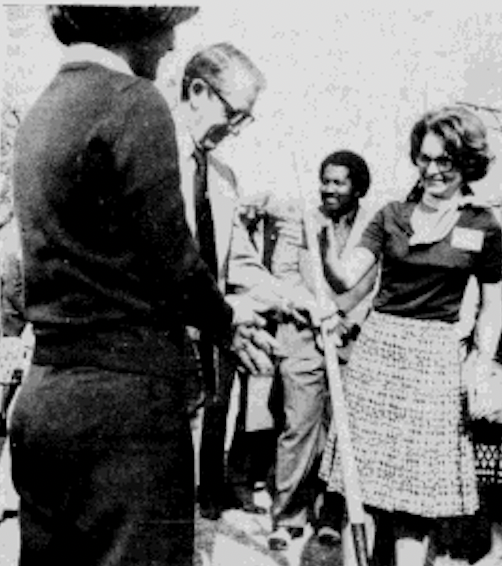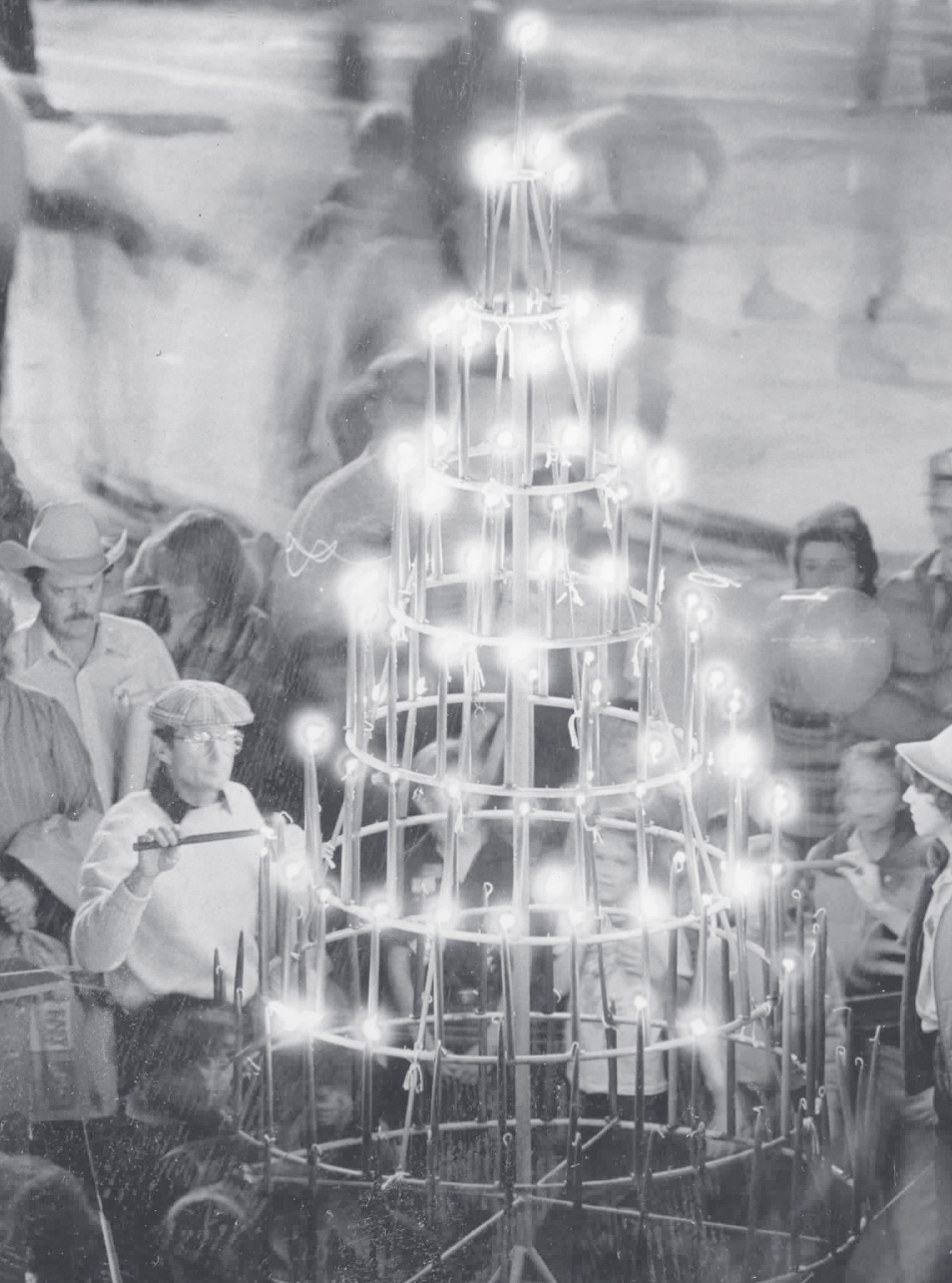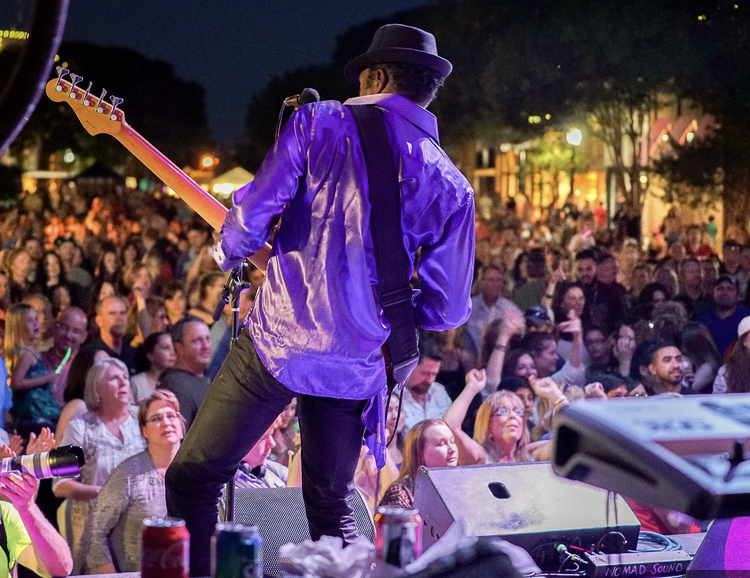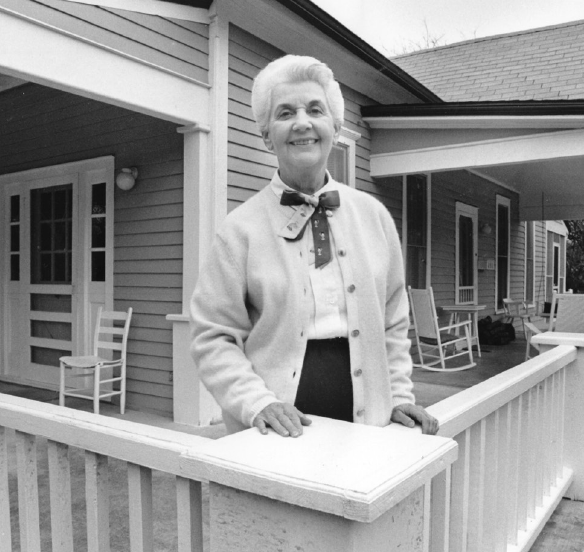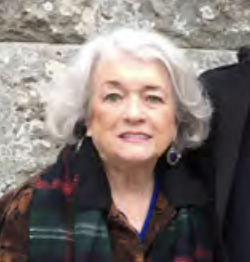Square-Saving Ladies
History saved—thanks!
We in Georgetown may be a bit biased, but we really may have the most beautiful town square in Texas! But what we see today is a far cry from what the Square looked like in the 1970s and 1980s. Our downtown was beset by the same factors that stressed small towns everywhere. Big box stores were siphoning away customers from small businesses on or near the square. Interstate highways kept visitors on the roadway instead of stopping and spending in our downtown restaurants and businesses.
This is what the square looked like back then.
Guess who turned downtown around to its present glory? You guessed it: It was a committed band led mostly by women who preserved the beautiful old buildings. They shepherded through multiple measures to make downtown a thriving tourist destination and major money-maker for the community.
Early Square fixer Laura Weir Clarke; thanks to Harold Shapiro
Preservation-minded folks started brainstorming how to save downtown in the early 1970s. Clara Stearns Scarbrough, co-publisher of the Williamson County Sun, had long been documenting history not just of Georgetown but of the entire county. Clara’s epic Williamson County history, Land of Good Water: Takachue Pouetsu (which is the indigenous Tonkawa people words for Land of Good Water), came out in 1973. “Clara was known for giving talks all around the county,” says Laura Weir Clarke, who with her mother Esther Messick Weir had also begun taking steps to rehabilitate the square.
Look for the Makemson-Steele-Weir markers on the north side.
The Weirs had been advocating for square preservation, and they acted on it, buying and rehabbing one of the oldest buildings on the square, the 1870-era Makemson-Steele building at 800 S. Austin. Laura was and is an architectural designer, so she was an integral part of the process.
Laura’s work echoes the female mark on the building: It’s named Makemson for Emma Dieckman Makemson, who owned and ran the City Hotel there. Emma and her hotel are included in the historical marker on the building—along with the contribution of the Weirs.
Masonic Building in the 1970s
A few years later, Laura would buy and transform the Masonic building at 7th and Main Streets, built in 1900 with its iconic onion dome.
This building, by the way, is where the Georgetown Woman’s Club members welcomed in any of the nearly 4,000 women who came from all over Wilco to register to vote for the first time in 1918! They kept their club room open to women who’d appreciate a cool drink and a restroom stop after their suffrage mission. Check that out here.
Masonic Building after Laura’s restoration
Preservation interest rose with planning underway for local celebrations to mark the nation’s bicentennial in 1976. JoAnn Morse and Lynn Storm led the Georgetown Historical Commission. Over two years, they directed history preservation projects such as a survey of old buildings that should be preserved—on the square and throughout the county.
Commission members solicited townspeople to get old photos and info to be held until a museum could emerge. They initiated history presentations for kids and adults. Member Clara Stearns Scarbrough shepherded the moving to Old Town Park of a historic cabin built in Georgetown’s earliest days.
Clara chronicled Wilco history, including this pioneer cabin. Photo courtesy of the Williamson County Sun
JoAnn and Lynn also coordinated the three-day July 4 bicentennial gala celebration, replete with old-fashioned sack races, whittling and spitting contest, tug-o-war contest, pet parade, county fair, barbeque, and fireworks.
Planting the Tejas Liberty Tree in Old Town Park for the Bicentennial celebrations, L-R: Lynn Storm, Mayor D. W. Scott, and JoAnn Morse with spade. Photo courtesy of the Williamson County Sun
The city took action on historical preservation in 1976, passing an ordinance aiming to protect the Square. Officials appointed a commission to oversee preservation of historic facades and guide signage. They solicited the federal Department of the Interior to designate downtown a historic district.
Genevieve Atkin; photo courtesy of the Williamson County Sun
In 1977, preservation activists created the Georgetown Heritage Society in 1977. Some key members included Lynn Storm, JoAnn Morse, Clare Easley (realtor and Georgetown’s first female school board members), Genevieve Atkin of the family business Atkin Furniture, Clara Stearns Scarbrough, and Eugenia Mahone Harrell.
Eugenia and husband Don bought the David Love building at 706 S. Austin Avenue and worked some magic on it. Merchant David Love had the building constructed around 1884, and Love’s family home at 1001 S. Church St. eventually became the home of suffragist and racial justice advocate Jessie Daniel Ames.
Before and after: Eugenia transforms the 1884 David Love building.
Eugenia turned the building into a popular antique and gift shop, attracting shoppers. And these rehabbed building projects served to inspire others to invest in fading downtown historical treasures and create new shopping opportunities.
Eugenia at her transformed store; photo courtesy of the Williamson County Sun
Eugenia was a preservation powerhouse, writes Williamson County Sun co-publisher Linda Scarbrough. She lobbied for grants, got historical designations, and constantly reminded policymakers and merchants that the Square could be an amazing financial boon for Georgetown. Eugenia would go on to support other magnets that brought people downtown, such as the Georgetown Art Center and the Williamson Museum.
Square-savers brainstormed special events that could attract lots of visitors downtown. Laura Weir Clarke proposed a Christmas Stroll and convinced the initially skeptical merchants of the Downtown Georgetown Association that it would be worth putting on a party to get people celebrating downtown. Laura would go on to create the Connecticut Trust for Historic Preservation (now Preservation Connecticut) and cofound the nonprofit Site Projects, which creates public art and events in New Haven, Connecticut.
Candle display at the first Christmas Stroll. Photo courtesy of the Williamson County Sun
Laura and her mother Esther Messick Weir were the guiding force for the first 1981 Christmas Stroll that ignited our beautiful annual festival that continues to pack the Square with holiday visitors and shoppers.
At the first Christmas Stroll in 1981, the Square was ablaze in holiday lights, just as it is now. Each visitor carried a light, and 100 actual candles flickered on a large metal tree. These days, the light show is spectacular, with the Courthouse and all the square stores glowing with lights.
And the Red Poppy Fest, the festival that’s the feather in Georgetown’s visitor-drawing cap, evolved largely because of Esther. Poppy Fest was preceded by the May Fair at the Square festival that began in 1999. The event, reminiscent of the May Fete held at Southwestern University for decades, had a May pole and other festivities for downtown visitors.
Maypole at May Fair on the Square. Photo courtesy of the Williamson County Sun
Esther could see potential in the Georgetown custom of growing red poppies, a custom that started when Georgetown WWI soldier Henry Purl Compton was impressed by the red poppies of Flanders and sent seeds home to mom Maggie, who lived at 507 East 7th Street.
The poppy seeds spread via bird and neighborly seed gifts, and word spread to visit for the annual poppy displays around town. Esther and others got a Red Poppy Festival going in 1990 that continues to delight locals and attracts thousands of tourists. Check out the book about amazing Esther and all she did for Georgetown that goes way beyond her role in the Red Poppy Festival!
The Poppy Festival draws in huge crowds with old-fashioned parades and enticing booths and popular performers.
The biggest boost to the Square’s revival came with federal assistance through the Main Street program, under the umbrella of the National Trust for Historic Preservation. The Main Street Program offered funding and support to preserve city centers nationwide where, like Georgetown, downtowns had gone downhill.
Preservation pioneer Anice Read
Texas was quick to get on the Main Street train, due to the activism of longtime preservationist Anice Read. She saw a way out for cities with dying downtowns, and saw the wisdom of the Main Street Program, with its core tactic of giving businesses tax credits for historic preservation. Anice jumped on it immediately, creating a Texas Main Street program that was one of the first nationally and was widely copied.
Linda Flory McCalla
Georgetown’s Linda Flory McCalla also jumped on board, and Anice mentored her as she did many other preservation advocates in Texas towns. Linda was the first to take charge of the Georgetown Main Street project in 1981.
Linda brought together downtown business owners, banks that would offer low-interest loans for renovations, government leaders, and civic groups such as the Georgetown Heritage Association (now called Preservation Georgetown) to save our downtown.
The Georgetown Main Street project results have won many preservation prizes. And in 2020 Linda won an Anice B. Read Award of Excellence in Community Heritage Development.
Linda still works to beautify the Square, serving on the Main Street 2030 plan. Here she is (second from right) with the current Main Street advisory board who are keeping our Most Beautiful Town Square in Texas just that!
Another key force to the Square salvation was Joan (pronounced JoAnn) King, Georgetown’s first female city council member. She and husband Morton moved here from Dallas and bought a historic house on Elm Street to fix up and preserve. They learned that just before they arrived, a historic home on University was razed to put in a gas station. Joan was struck by the lack of zoning laws that resulted in businesses springing up next door to historic properties.
Joan wanted to have a hand in preservation change, but she noticed that there wasn’t a single woman on the advisory boards. When she asked the mayor about that absence, he said, “Oh, women wouldn’t want to do that.” She learned that some doubted that women could understand big budgets and blueprints and the like. Joan had a little bit of familiarity with such things: In Dallas, she’d been in charge of building student housing all over Southern Methodist University, overseeing a multi-million dollar annual budget.
Joan King, taking care of preservation and better government; photo courtesy of the Williamson County Sun
Joan pushed to get appointed to the planning and zoning committee. When she decided to run for city council in 1984, some warned her that a woman was a no-go. But lots of women got behind her, and she won her at-large position, with many more votes than her six competitors.
Renee Hanson, Georgetown’s first city planner; photo courtesy of the Williamson County Sun
During her two council terms, Joan pushed for transparency and professionalism in city operations. She advocated to hire Georgetown’s first city planner to set rules for builders that were best for all the community. Planner Renee Hanson started part-time and worked to set up a solid planning department that guided more sensible preservation regulations.
A huge part of preservation is recording the history—the full history—of a place. Southwestern History professor Martha Mitten Allen did countless interviews of older Georgetown residents. She got community members and students to join her. They produced a four-volume history of Georgetown. You can read them all at Preservation Georgetown.
Martha did critical work on her own and with her students to keep alive often forgotten voices in our community, interviewing and recording everyone from descendants of slaves to Latinas and female community leaders in Georgetown.
Martha (on the right) joins in with the quilting bee at Handcrafts Unlimited.
Martha often focused on forgotten women in her work and teaching, and she helped bring Women’s Studies to SU. In 1979, she developed the first Black History course and co-taught it with Huston-Tillotson College professor Lamar Kiraven, and they held classes on both campuses.
Martha, a livelong quilter, also spearheaded the effort to launch Handcrafts Unlimited, the artisan store at 104 W. 8th Street on the south side of the Square. Her idea was to create a space where women could sell their work and run the store together.
It worked—Handcrafts Unlimited opened in 1983 and volunteers operate the store to this day. “Women’s work”—the handmade stuff we often treasure the most—is what’s sold here, and artisans get a share of the sale.
A quilting bee group still meets to make quilts together.
Handcraft’s historic home building was also a rescue job by a woman, Jo Ella Simon Broussard. Jo Ella loved the historical legacy of the Allen & Landrum building: It had been a grocery store, cigar shop, millinery/dress making shop, bookstore, harness shop, and confectionary.
Jo Ella Simon Broussard
But when she bought it in 1983, it was in sad shape, particularly the upstairs where she hoped to live with her family. Rats and bats had infested the rooms, and everywhere there was rot and rust.
But Jo Ella saw the beauty of the building, and invested in restoring it. Jo Ella’s family spent many happy years living there on the Square with Handcrafts humming along below.
Of course, men were a part of the square-saving crew, and Sun editor Linda gives a shout-out to former mayors Leo Wood and Carl Doering, City Council members Clark Lyda and Sam Pfiester, and Harry Gold, who with spouse Rebecca owned the long-lived Gold’s department store on the Square . Thanks to all who kept the Square alive and thriving!
And thanks to the City of Georgetown for their awesome video about the square savers (with a shout-out to me and this website, thank you), produced to celebrate 40 years of our Main Street program—one of the longest-running programs in the country.
Harry Gold and others in business and government helped fix up the square.
Take your time walking around Georgetown’s Square—there’s so much to see in our revitalized and very popular square. Below, some don’t-miss stopping points, and a few suggestions to visit history just off the Square.
☛ First, find a place to hunker for a bit, such as a bench on the Courthouse lawn. Picture these glimpses of what people saw around the Square, and imagine life back then.
“First Monday” in Georgetown, going back to the later 1800s, was the day to do business out in the street at the Square. Cattle trading and commerce of all sorts went on, as folks lined up buggies or hitched their horses to hitching rings that remain to this day. Visitors could eat their box lunch under long picnic tables under the trees.
Birds-eye view looking west from the Square: The long building in the center situated perpendicularly sits alongside the railroad tracks that went all the way downtown. The white church center-left back is one of our oldest, St. Paul United Methodist Church, and a more modern St. Paul UMC remains at 610 Martin Luther King Street.
Cotton was a top commodity here for many years. Georgetown once had several cotton gins; only one long-closed gin remains at 20th St. and Brushy Street—the original name for what became Austin Avenue.
Birds-eye looking past the east side of the Square; later you’d see Southwestern University
A parade around the Courthouse in the 1920s
☛ Start at the southwest corner of the Square, where you’ll find the Steele-Makemson-Weir building at 800 S. Austin Ave. Read the historical plaques on the north side of the building that includes Emma’s time here as hotel owner. Maybe this is her above, standing by the side entrance on the north side!
Jovita Zavala: Not today, ticket-taker
☛ Head south down Austin just half a block to the Palace Theater. Georgetown folks have poured much into restoration of this Art Deco wonder built in 1925 and initially showing silent films and then “talkies.” After the movies stopped, theater fans got involved to create loads of programming including plays, dance and music performances, theater classes for kids, and more. Back in the days when the Palace (and most all of Georgetown establishments) was segregated, learn how Jovita Zavala said “Nope.”
Lois ran Acme Cleaners.
☛ Come back up to the Square and saunter down the south side of the Square. Meander in the many enticing stores. Many of the owners and operators are and were women, such as Jemme Lynn Wilks, owner of the home décor store La Bella Casa. And this store once housed a longtime female boss, Lois Sharp, who ran Acme Cleaners in the building, which previously hosted Burkhart’s News Stand.
Lois was a welcome sight to many residents—she’d pick up AND deliver laundry. When she retired in 1977, she credited her longtime employees Beatrice Miller and Blenda Lind for the store’s success.
Rin Etter and her daughter Dorothy Miller owned Rin’s Dress Shoppe here on the south side of the square in the 1970s and started other stores. Check out the history of other Georgetown businesswomen!
And wander into the women-founded Handcrafts Unlimited at 104 W. 8th Street. Check out all the awesome handmade finery inside. Maybe there’ll be a quilting bee going on! Picture the days when this was Price Brothers Grocery Store and a saddle shop—check out this cool building history.
☛ Continue east to the intersection and look at the Dimmit Building. at the southeast corner of 8th and Main streets. It’s named after P. H. Dimmitt, but his daughter Lil took over the building when he died and went on to buy and manage many other properties. Learn a bit more about Lil here.
And look in the windows of the Dimmitt building and picture this famous habitué: Lyndon Baines Johnson! Johnson would frequent Georgetown and smooze his Georgetown constituents while he was our Congressmember. He liked to work the folks at the soda fountain that was once here. Here’s youthful LBJ at right in 1937 with President Franklin Delano Roosevelt and then Texas governor James Allred.
☛ Head north on Main Street and stop in at Divine Treasures on the corner. Picture when Margarite Holt, owner of her Hill Country Bookstore here, got loads of folks headed to the Square for superfun events such as her Harry Potter parties! Head here to see pix of all the revelry when kids, parents, and Square merchants would offer Potter-related goods as hundreds enjoyed the Square.
☛ Head into The Escape to peruse the vast array of gifts and such. As you shop, visualize shopping for some new duds when this 1902-era building was Hoffman and Sons Dry Goods store. While the store was indeed founded by W. P. Hoffman and joined by son Billie, the day-to-day business with women’s wear happened because of Bertha Swenson. Check out particulars about Bertha and other women business women who owned and operated stores on the Square and elsewhere.
Bertha Swenson sits center front among the other past presidents of the Georgetown Business Women League who also kept businesses bustling on the Square and elsewhere.
☛ As you escape The Escape, pause on Main Street and look toward the Courthouse as you imagine that it’s winter and time for the Christmas Stroll. Picture the hundreds of thousands of holiday lights twinkling all around the Square as throngs of visitors enjoy the stroll. Give a thumbs-up to all who thought up this cool event and tried out new ideas to increase the fun and the visitors.
Take a look above at the photo of the giant metal candelabra holding 100 real flaming candles, and listen to this story related by Linda Scarbrough, who worked with other women to put on this and other Square events. “Those candles were blazing away and some choir members who were nearby were getting a little anxious about the proximity,” she remembers. “We finally got them calmed down and of course nothing happened. Those candles sure were beautiful, but I don’t think we brought out that candle stand again.”
Shop owner Sallie Atkin stands at left—she ran the shop before and after her husband died.
☛ Walk up Main to the corner where Gumbo’s is now. Genevieve Atkin and her mother Sallie once were instrumental in running the S. T. Atkin Furniture Store here. Genevieve was a big Square booster who worked to preserve these historical buildings and other aspects of Williamson County history.
Take a good look at this magnificent Masonic building, which was rescued from shabbiness and rehabbed exquisitely by Laura Weir.
Esther on the right preaching preservation—thanks!
☛ As you round the Square on the North Side, walk on the Courthouse side so you can observe the gorgeous restored facades. Take a time trip back to the 1970s when the Square looked rather dismal in comparison. Do a shout-out to Esther Weir, a primal force in the Square saving effort. Here she is getting other women on the Square preservation bandwagon. Thanks to all who got on that bandwagon and drove it expertly to the goal!
☛ Keep looking at facades as you walk down the west side of the Square. Make sure to check out the David Love building mid-block at 706 S. Austin and look at the before and after photos above that resulted when Eugenia Mahone Harrell and her husband brought it to its former splendor. Which is your favorite building? The beauty of the gift of the Square restoration effort is that we don’t have to choose—enjoy them all!










